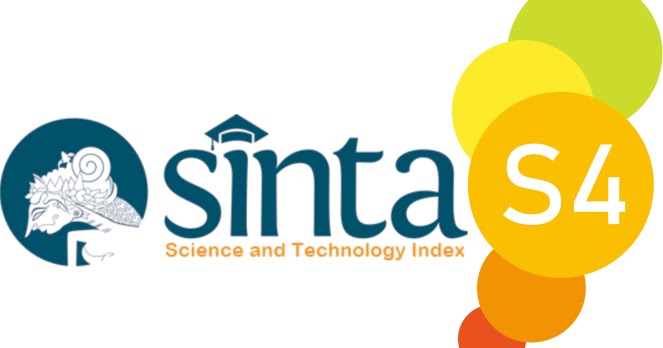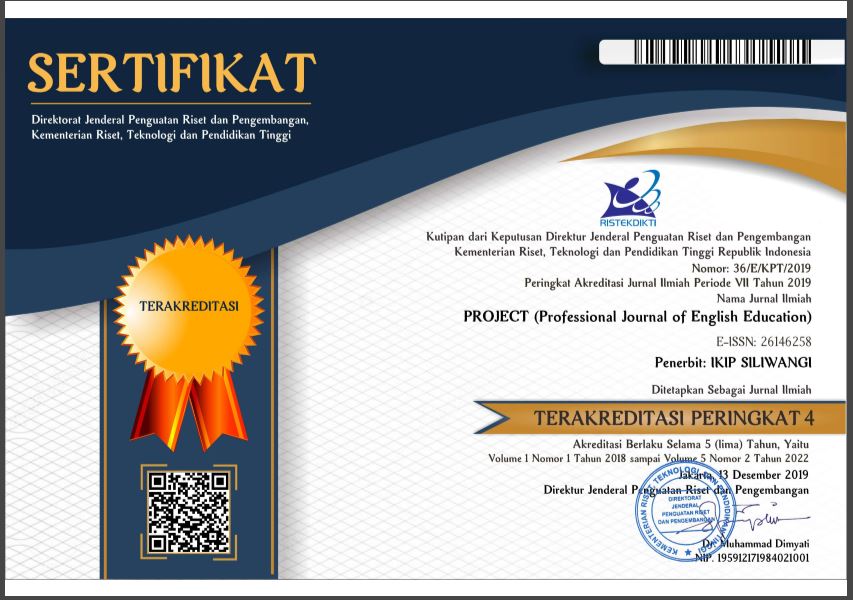Enhancing Self-Confidence in English Speaking through Role-Play Activities
Abstrak
This study aimed to increase students' grade 9 student’s self-confidence in speaking English at one Junior High School in Jakarta. This study uses the Classroom Action Research (CAR) method which aims to solve the problem of students' lack of self-confidence in speaking English. This classroom action research uses the Kurt Lewin model. This study was conducted in 2 cycles where each cycle consists of planning, action, observation, and reflection stages. In obtaining data, the researcher used qualitative and quantitative methods. Qualitative data were obtained through observation, while quantitative data were obtained through tests (pre-test and post-test). The results of this study found that the use of the role-play method had been successful with the criteria that 75% of students achieved the target score ≥ 75 based on the Minimum Competency Criteria (KKM). The results obtained through the test showed that 80% of students had achieved the target minimum competency criteria score. In addition, the second criterion is that students become more active during the teaching and learning process, so the results of the observation show that by using the role-play method, students become more active and also confident in speaking English.
Referensi
Alabsi, T. A. (2016). The Effectiveness of Role Play Strategy in Teaching Vocabulary. Theory and Practice in Language Studies, 6(2), 227. https://doi.org/10.17507/tpls.0602.02
Alzboun, B., Smad, O. M., & Baniabdelrahman, A. (2017). The Effect of Role Play Strategy on Jordanian EFL Tenth Grade Students’ Speaking Skill. Arab World English Journal, 8(4), 121–136. https://doi.org/10.24093/awej/vol8no4.8
Aras, A. W., Hamid, R., & Mannong, A. B. M. (2022). The Psycholinguistic Analysis of Student Problems in Speaking English. Indonesian Journal of Psycholinguistics, 1(1), 9–15. https://doi.org/10.56983/ijp.v1i1.137
Bandura, A. (1994). Self‐efficacy. The Wiley Encyclopedia of Personality and Individual Differences, 1994, 387–391. https://doi.org/10.1002/9781118970843.ch243
Brown, H. D. (2019). The Cambridge Guide to Research in Language Teaching and Learning.
Bunaya, M. S., & Basikin. (2019). Improving Speaking Confidence by Using Think Pair Share (TPS) Teaching Strategy to High School Students. Advances in Social Science, Education and Humanities Research, 326(Iccie 2018), 349–355. https://doi.org/10.2991/iccie-18.2019.59
Creswell, J. W., & Creswell, J. D. (2018). Research Design: Qualitative, Quantitative, and Mixed Methods Approaches. In Research Defign: Qualitative, Quantitative, and Mixed M ethods Approaches.
Karsudianto, F. (2020). Improving students’ motivation and self-confidence in speaking using mingling games. Journal of Applied Studies in Language, 4(1), 1–8. https://doi.org/10.31940/jasl.v4i1.1591
Lander, J. A., & Brown, H. D. (2001). Teaching by Principles: An Interactive Approach to Language Pedagogy. In Language (Vol. 71, Issue 4, p. 843). https://doi.org/10.2307/415773
Lestari, T., Mulyana, E. H., Nurzaman, I., Gandana, G., & Apriyaningsih, E. (2019). Exploring the integrating potentials of role playing with YouTube in building student’s self confidence. Journal of Physics: Conference Series, 1318(1), 0–7. https://doi.org/10.1088/1742-6596/1318/1/012014
Lewin, K. (1946). Action Research and Minority Problems. Journal of Social Issues, 2, 34–46. http://bscw.wineme.fb5.uni-siegen.de/pub/nj_bscw.cgi/d759359/5_1_ActionResearchandMinortyProblems.pdf
Maulana, I., & Lolita, Y. (2023). The Effectiveness of Role- Play To Improve Student ’ s Speaking Achievement. 3(2), 122–135.
Muqorrobin, M., Eko Bindarti, W., & Sundari, S. (2022). Factors Contributing to Learners’ Lack of Self-Confodence in Speaking English. EFL Education Journa, 9(1), 27–37.
Pardede, E., Sitanggang, M. M., & Saragih, S. S. (2022). Speaking Problem of Junior High School Students. Journal of Humanities, Social Sciences and Business (Jhssb), 1(2), 43–48. https://doi.org/10.55047/jhssb.v1i2.98
Pujiani, T., Nisa, K., & Krisbiantoro, B. (2021). Improving the Students’ Self-confidence in Speaking English through YouTube. International Journal of Health Science and Technology, 2(3), 166–176. https://doi.org/10.31101/ijhst.v2i3.2173
Purnamawati, S., Sofian, & Suhartono, L. (2015). The Use Of Role-Play In Teaching Speaking. Jurnal Pendidikan Dan Pembelajaran, 4(9), 1–13.
Sagimin, E. M. (2012). Teaching Speaking Using Role Play Technique (a Case Study at the Eighth Grade of SMP N 17 Tangerang Selatan). Paradigma Lingua, Jurnal Peenelitian Bahasa Dan Sastra, 1(2), 124–140.
Srinivas, P. (2019). The Importance of Speaking Skills in English Classrooms. Alford Council of International English & Literature Journal, 2(2), 6–18. www.acielj.com
Tipmontree, S., & Tasanameelarp, A. (2020). Using role playing activities to improve thai EFL students’ oral English communication skills. International Journal of Business and Society, 21(3), 1215–1225.
Tshering, T. (2022). The Implementation of Role Play to Improve Speaking Skill: An Action Research with Grade Six Students. Asian Journal of Education and Social Studies, 31(2), 30–37. https://doi.org/10.9734/ajess/2022/v31i230745
Yoniswan. (2020). Effects of Role-Play on Indonesian Junior High School Students’ Speaking Skills: a Classroom Action Research Study. SALEE: Study of Applied Linguistics and English Education, 1(02), 1–9. https://doi.org/10.35961/salee.v1i02.120
Yuliana, Y., Kristiawan, M., & Suhartie, T. (2014). The Effect of Role Play Toward Students’ Speaking Skill (an Experiment Study at Grade XI IPA High School 1 Batang Anai, Padang Pariaman Regency, West Sumatera, Indonesia) Mapping Managerial Competence of Primary School Principals in South Sumatera View pr. The Journal of Applied Sciences Research Journal Homepage, 1(4), 279–283. http://www.journals.wsrpublishing.com/index.php/tjasr





